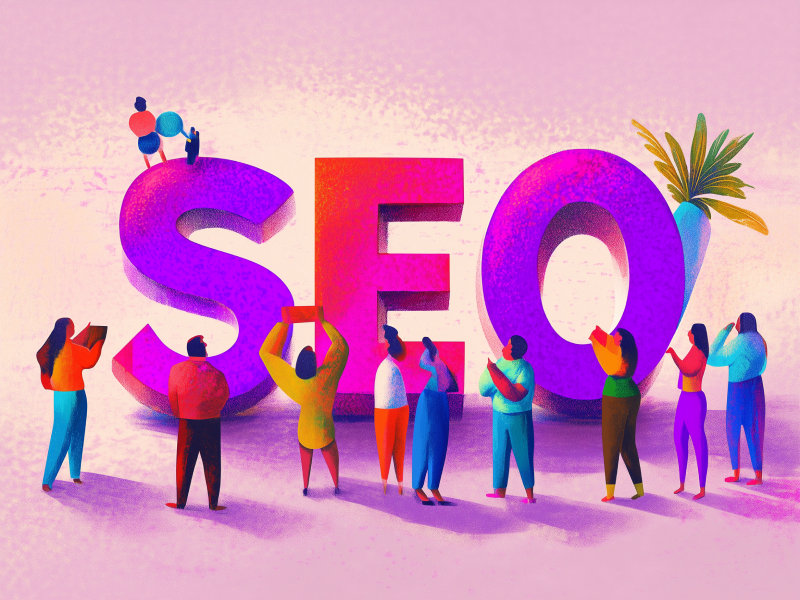Why SEO is so important
Search Engine Optimization (SEO) is a strategy designed to improve a website’s visibility in search engine results. It involves optimizing various aspects of a website to attract more traffic from free, organic, editorial, or natural search results.
When appearing higher in search results, websites increase their exposure to potential customers who are actively searching for the products or services they offer.
SEO includes techniques such as on-page and off-page optimization, keyword research, content creation, and technical adjustments.
SEO’s goal is to improve the relevance and authority of a website, making it more likely to rank higher on search engine results pages (SERPs). Effective SEO attracts the right audience, leading to better engagement and higher conversion rates.
SEO is key in digital marketing due to its ability to impact a website’s visibility and traffic. High search engine rankings directly correlate with increased website visits, potential leads, and conversions.
The top result on Google’s search page has an average click-through rate (CTR) of 27.6%, with the second result dropping to 18.7% and the third to 10.2%. This shows the importance of achieving top positions on SERPs to maximize visibility and traffic.
AI algorithms, such as Google’s RankBrain, have shifted SEO past keyword matching to understanding the context and intent behind search queries. Evolution requires SEO strategies to focus on content relevance, user experience, and behavioral signals to align with search intent.
Modern SEO practices must consider technical aspects and user behavior and search context.
The benefits of SEO for your website
SEO improves a website’s visibility, making it easier for potential customers to find it. Higher rankings on SERPs drive more organic traffic, as users are more likely to click on top results. Updating content on a high-performing blog that has dropped in the rankings can restore or improve its position, leading to increased visibility and traffic.
Data from the ‘2024 State of Marketing & Trends Report’ shows that a quarter of web users never go past the first SERP. When optimizing various elements of a website, businesses can improve their rankings and reach a broader audience.
Supercharge your web traffic with SEO strategies
SEO aims to drive web traffic When securing higher rankings. The top organic result on Google is ten times more likely to receive a click than the tenth result, illustrating the impact of ranking on traffic volume.
Featured Snippets, appearing above the first organic result, offer concise answers to user queries and can increase traffic. To secure a Featured Snippet, content must be structured to answer common questions effectively. Achieving this position can dramatically boost click-through rates and drive substantial traffic.
Establish your website as an authority with SEO
SEO can improve a website’s Page Authority (PA), a metric indicating trustworthiness, quality, relevance, and value. PA scores range from 1 to 100, with higher scores suggesting a more authoritative site. High-quality content, reputable backlinks, and low spam levels contribute to a higher PA.
Improving PA aligns with Google’s E-E-A-T principles: Experience, Expertise, Authoritativeness, and Trustworthiness. Websites demonstrating strong E-E-A-T are more likely to rank higher, as Google prioritizes reliable content. Building authority requires a focus on informative content and earning backlinks from respected sources.
Improve your customer experience through SEO
SEO is also about improving the user experience on a website. Optimizing site responsiveness and reducing load speed directly improves the user experience by lowering bounce rates and encouraging visitors to spend more time on the site. A responsive design makes sure of accessibility and ease of navigation on both mobile and desktop devices.
Quality content that aligns with user intent and provides value without distractions is key to SEO. When visitors find the information they need quickly, they are more likely to engage with the site and convert. SEO practices that focus on usability and content relevance improve rankings and foster a positive user experience.
The must-have elements to perfect your SEO game
Keywords are central to SEO, connecting what users search for with the content websites provide. Effective SEO involves thorough keyword research to identify terms with high search volume and low competition. Keywords should be naturally integrated into content to align with user search intent.
Different types of keywords serve specific purposes:
- Short-tail keywords: Broad terms like “dog” that attract high traffic but are highly competitive.
- Long-tail keywords: Specific phrases like “terrier puppies for sale” that attract targeted traffic and have higher conversion rates.
- Local keywords: Location-specific terms like “puppies for sale in Boston,” crucial for targeting local audiences.
Pro tips for effective keyword research
Keyword research requires analyzing search trends and user behavior. Longer keywords (10-15 words) generate 1.76 times more clicks than shorter terms, emphasizing the value of targeting specific queries.
URLs containing keywords related to search terms see a 45% increase in click-through rates, highlighting the importance of keyword-rich URLs.
Content that converts
Content plays a key role in SEO. When engaging audiences and providing valuable information. High-quality content that is educational, relevant, and shareable tends to rank well and attract organic traffic.
Diverse content types, such as blogs, videos, infographics, and webinars, cater to different audience preferences and improve SEO.
How to create killer content that ranks
Creating effective content requires understanding audience needs and search intent. Content should provide clear, concise answers to common questions, which can help secure
Featured Snippets and improve visibility. Tools like Google’s “People also ask” feature can provide insights into popular queries, offering valuable ideas for content creation.
Boost your SEO with winning off-page techniques
Off-page SEO includes strategies outside a website to improve its rankings, such as building high-quality backlinks from authoritative sites like Forbes or The New York Times. These backlinks indicate credibility and trustworthiness, boosting authority and ranking potential.
Effective off-page SEO strategies include guest blogging, producing original research, and leveraging influencer marketing. Quality backlinks from reputable sources are more valuable than a large quantity of low-quality links, contributing to a website’s authority.
Dominate local searches with smart SEO tactics
Local SEO is key for businesses looking to attract local customers. Optimizing for local search terms and maintaining accurate business listings can increase visibility to local consumers searching for products or services.
Key local SEO tactics include using local keywords, maintaining consistent business listings across directories, optimizing for mobile and voice search, and claiming Google My Business profiles.
Encouraging local reviews and engaging with directories like Yelp further improve local search presence.
Why local SEO can’t be ignored
Local SEO is increasingly important as more users rely on mobile devices and voice search. With 58% of mobile users engaging in daily voice searches and 91% of consumers saying local branch reviews impact their perception of big brands, optimizing for local search is essential for building a strong local presence.
How to use SEM for greater SEO success
Search Engine Marketing (SEM) uses paid marketing tactics to complement SEO and improve visibility. SEM helps businesses reach targeted audiences effectively through paid search ads, display ads, and other forms of paid advertising.
SEM activities include various forms of paid advertising like paid search (PPC marketing), display ads, local search ads, and video ads. Strategies can be tailored to target specific audiences and achieve different marketing goals.
Integrating SEM with SEO maximizes online reach When combining organic and paid strategies. In 2023, search advertising accounted for 40% of online ad revenue in the United States, showing the importance of paid search in digital marketing. Using both SEO and SEM improves visibility and attracts a wider audience.
AI’s role in SEO
AI advancements have transformed SEO practices, helping search engines to better understand user intent and context. AI algorithms like Google’s RankBrain, BERT, and MUM have improved the ability to interpret complex queries and deliver more precise results, making SEO more dynamic and nuanced.
In order to optimize for AI, businesses should focus on intent targeting, create diverse content formats, maintain robust technical SEO practices, optimize for voice search, and make sure of their content consistency across channels.
Statistics show that 15% of searches on Google daily are entirely new, highlighting the need for continuous adaptation in SEO strategies. Constant change requires businesses to stay updated with the latest trends and technologies to remain competitive.
How SEO saves you from search engine pitfalls
SEO is key for overcoming the limitations and imperfections of search engines. Issues like improper link structures, coding errors, duplicate content, non-textual content, and language semantics can negatively impact rankings.
Effective SEO practices help address these issues, making sure a website remains accessible and relevant.
Understanding SEO fundamentals and focusing on creating relevant, valuable content aligned with searcher intent is crucial for achieving high rankings. Addressing both technical and content aspects of SEO improves online visibility, attracts more traffic, and drives better business outcomes.





